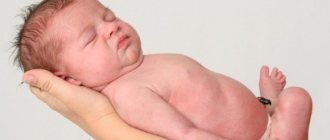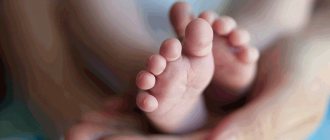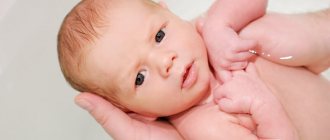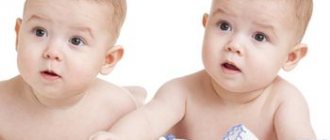It is known that the development of many internal organs and systems of a small child continues for some time after birth. In babies under the age of one 18 months, the formation of thermoregulation processes has not been completed, so they easily overheat and freeze, while for adults the environmental atmosphere seems quite normal. Having discovered cold hands and feet on their baby, many young parents give in to panic, begin to wrap the child in warm blankets and wonder what disease has struck their beloved child. The article discusses whether cool and damp limbs are a symptom of an incipient disease or whether this is a completely natural state of the baby.
When is blueness around a baby’s mouth normal?
Blue discoloration of the nasolabial triangle can be observed in healthy children. A pathological condition can be excluded by careful monitoring of the newborn baby. Physiological cyanosis occurs:
- in the absence of problems with growth and development;
- during normal heart function;
- if the skin color on other parts of the body does not change;
- with good general health and activity;
- in the absence of cough and normal nasal breathing;
- if the child is not lethargic and sleepy.
While crying
During strong crying, the child takes deep exhalations and short breaths. When a baby cries, it causes a lack of oxygen in the body and the nasolabial triangle turns blue. As a rule, this condition disappears as the baby grows and his respiratory system develops. If, after normalization of breathing, the skin color does not return to normal for a long time, you should consult a specialist.
After or during bathing or changing clothes
During or after swimming in cool water or when changing clothes, your baby may feel cold. When exposed to low temperatures, blood vessels narrow. This condition is normal, but causes blueness of the nasolabial triangle. After body temperature normalizes, skin color also normalizes.
During feeding
While suckling the breast, the baby spends a lot of strength and energy. Blood vessels dilate and become more visible when receiving food. Most often, this condition is observed in children under 3 months. The skin color returns to normal within a few minutes after feeding. If the condition does not return to normal, parents should take the child to the pediatrician.
If your baby has thin skin
Blue discoloration of the chin and skin around the mouth may occur in infants with thin, fair skin. In this case, the change in skin color will be noticeable not only on the face, but also on other parts of the body. This is due to the presence of blood vessels close to the surface of the skin, which are visible through it. If the skin turns blue during feeding or bathing, this condition is not a pathology; over time it will acquire a normal appearance.
Did you know that this cheap remedy can save you from hyperhidrosis?
Judging by the fact that you are reading these lines now, victory in the fight against increased sweating is not yet on your side...
And have you already thought about extreme measures? This is understandable, because experiencing constant discomfort and awkwardness becomes unbearable. Wet palms, armpits, back, legs... All this is familiar to you firsthand. But perhaps it would be more correct to treat not the effect, but the cause? We recommend reading the story of Olga Larina, how she got rid of hyperhidrosis once and for all...
It only takes a few seconds for a newborn to “emerge” from the aquatic environment, readjust itself and begin to breathe air. A short cry - the baby took air into his chest - and now he is breathing on his own, switching to pulmonary breathing. But it may take another couple of weeks until the baby fully adapts to the new conditions. During this period, he experiences some alarming symptoms for inexperienced parents, such as sudden breathing pauses, blue lips, rapid pulse, and some strange heart tones. As a rule, this is not a cause for serious concern: frightening phenomena are explained by the fact that the baby’s blood circulation must adapt to completely different conditions of “extrauterine” life. In the first weeks of life, a newborn
completely occupied with adapting to new living conditions. He has not yet understood how day differs from night. Of the 24 hours that make up a day, he can sleep a total of 18 to 20 hours. Sleep is a baby’s means of “self-defense.” In order not to be overloaded by numerous environmental factors, his system simply turns off.
When the baby is looking for the nipple of the mother's breast, you just have to touch his cheek or touch his lips with your finger, and he begins to make sucking movements. These are manifestations of an innate reflex. The grasping reflex fades away after three to four months. Other reflexes remain for life: blinking, breathing, swallowing, coughing, sneezing.
The baby cannot yet change its position on its own. Just lying on his stomach, he tries to overcome the powerful force of gravity: at least for a couple of seconds, but raise his head.
A newborn can see, hear, feel, and smell, although his senses do not work the same as those of an adult. A baby can see very clearly by about six months. At this age, it is best for him to view objects from a distance of twenty-five centimeters. But now the child is able to identify people’s voices and distinguish them from other sources of noise. When a baby hears the familiar voice of his mother or father, he begins to show increased attention and is not interested in other acoustic noises.
- Feeding on demand is the most appropriate during this period. The baby wakes up every two to three hours, and sometimes even more often.
- In the first weeks, try to be more discreet with the pacifier. This will benefit breastfeeding. Help the child, bring his hand to his mouth, let him suck his fist better - this is a wonderful way of comforting him.
- You don't have to tiptoe around all the time. This is unusual for both you and the baby, making it more difficult for you to fall asleep and stay asleep.
- Baby baths are too big for the baby at first. Be careful! It is better to bathe in a round basin. To prevent your baby from slipping, place a soft towel on the bottom.
A newborn's heart beats quickly, making 110-150 beats per minute (in adults, 70-80 beats are considered normal). It beats at such a speed because it is small and, accordingly, the volume of blood it pumps in the body is still small. Since the heart beats quickly, the baby breathes quickly.
In the first weeks of life, a baby can take up to 50 breaths per minute, which are also irregular and noisy. Some also sigh heavily, snore, and sniffle loudly. And only in the deep sleep phase do they breathe silently, which again worries parents very much. Adapting to a new environment is hard work for a baby, so short pauses in the breathing process are normal. Sometimes a whole second passes - an eternity! — while the baby takes his next breath.
You need to sound the alarm if the child suddenly turns pale or blue during this breathing pause - then urgent medical intervention is necessary.
When a baby cries loudly, he can also turn blue, because when he screams, the breathing rhythm is disrupted, and the waste blood, not sufficiently enriched with oxygen, returns to the circulatory system. As soon as you pick up the child, take him in your arms and calm him down, the skin returns to its normal pink color.
Yellowing of the skin in a newborn is also associated with the restructuring of the body. Since the baby is already breathing on his own, he now needs fewer red blood cells than during his stay in the mother's womb. Their excess is processed in the liver, resulting in the formation of bilirubin, which turns the skin yellow. Three quarters of newborns have jaundice, but after a few days there is no trace of it.
There is another important problem - heat conservation: the child must constantly maintain a slightly elevated temperature in his body - from 37 to 37.5? C. Hypothermia is dangerous for him, because in this case the body requires more oxygen to retain heat. In this situation, it is useful to put a hat on the newborn; it protects him well, because the heat mainly goes “through the head.” Cold hands or feet are not yet an indication that the baby is hypothermic. Clothes for newborns should not be too warm and irritating. In the first days, it will be enough to swaddle the baby and you should not immediately dress him in rompers and overalls. It is better to touch the skin on the back and tummy; it should be pleasantly warm, but not sweaty - this symptom shows that the baby is feeling well.
For unstable blood circulation, a cold bed is also a big burden. Cold means extra work for the heart - it needs to work harder to replenish the missing heat. Therefore, before putting your baby in the crib, be sure to warm up the bed, for example, by placing a heating pad or a bottle of hot water in it (the bottle should then be removed or placed so that the baby cannot accidentally touch it).
The newborn period is a particularly difficult time for a child. This is a period of adaptation to environmental conditions - existence outside the womb. The functions of all organs and systems are being restructured: respiratory, cardiovascular, digestive, excretory, immune, etc. Many problems and many questions may arise for mom and dad during this difficult period. Therefore, the baby must be under constant medical supervision - starting from the maternity hospital, and then in the clinic at the place of residence. The child undergoes the first examination immediately after birth. Before he was even born, the first marks were already being put. Doctors evaluate the baby's health by testing him using the Apgar score. The heartbeat, breathing, skin color, muscle tension are monitored, and innate reflexes are checked. Most kids get seven or eight points. They take a closer look at the results of this “exam” when some delay in the child’s development appears.
The doctor listens to his heart, lungs, feels his head, tummy, limbs; checks sucking, grasping, plantar and other important functions characteristic of a newborn. In the maternity hospital, the child will receive the first vaccinations: the first hepatitis B vaccination is carried out within 24 hours; On the third to seventh day of life, a healthy newborn is vaccinated against tuberculosis (BCG).
Then, on the first or second day, a doctor from the children's clinic comes to your home. He gets to know the mother, the living conditions of the family, and finds out the peculiarities of the course of pregnancy and childbirth. After a detailed interview and a thorough examination of the child, the doctor should tell the mother about the features of the adaptation period: explain why the baby loses weight in the first days, what a sexual crisis is in girls and boys (swelling of the mammary glands, bleeding in girls and swelling of the scrotum in boys) . The doctor and local nurse teach the mother to treat the umbilical wound with brilliant green or a solution of potassium permanganate until complete healing. This is important because the umbilical wound can become an open door for infection. Advice on feeding, bathing and caring for a newborn is also given.
During the first month of life, the doctor visits the child three times. When the baby is one month old, mother and child are invited to the children's clinic for an appointment. Weighing is carried out, height and chest and head circumference are measured. The doctor checks whether the child is developing properly, gives nutritional recommendations, and explains the benefits of breastfeeding. Children are often prescribed vitamin D to prevent rickets. At one month of age, the child receives a second vaccination against hepatitis B. In addition, the mother and baby should have an appointment with specialists: a neurologist, an ophthalmologist, or an orthopedist.
Early diagnosis of abnormalities in the child’s health helps timely and successful treatment.
Acrocyanosis is a disease in which the limbs turn blue. The appearance of fingers and toes is frightening because they take on unnatural external characteristics.
It is not necessary that only the limbs are affected. Lips, nose, ears can also turn blue or dark. To understand what acrocyanosis looks like, see the photo.
Often some areas of the face turn blue. Acrocyanosis of the nasolabial triangle occurs in many people. If it appears, you should at least be wary. The reasons for the appearance in any case are extremely negative. If a person experiences blue discoloration of any part of the body, this is a reason to seek help from a specialist as quickly as possible.
Cyanosis and acrocyanosis have many similar characteristics. Cyanosis is cyanosis in common parlance. It occurs due to the high content of hemoglobin. Acrocyanosis is a manifestation of cyanosis.
The worst thing is that cyanosis is a symptom and expression of hypoxemia. But it often happens with heart diseases. A person suffering from this disease has a bluish color to his limbs.
When is it necessary to consult a doctor?
The well-known pediatrician E. O. Komarovsky advises closely monitoring the child’s condition in order to understand when blueness of the skin around the mouth appears. Finding out the cause of cyanosis will help make the correct diagnosis and prescribe treatment, if necessary.
If you notice blueness of the nasolabial triangle, you should consult your doctor. The specialist will make an accurate diagnosis, rule out or confirm the presence of a pathological condition and tell you what to do so that the situation does not recur. The appearance of a symptom should not be ignored, as it may be a sign of a serious illness.
Mandatory consultation with a pediatrician is necessary if:
- the presence of an infectious disease of the upper or lower respiratory tract;
- impaired nasal breathing;
- long-term preservation of blueness;
- suspicion of a foreign object entering the respiratory system (it is prohibited to independently remove small particles with tongs and fingers);
- blueness of the tips of the fingers, hands and feet.
To reduce the risk of developing cyanosis, you must adhere to the following recommendations:
- monitor the air temperature and humidity in the room;
- bathe the baby in warm water;
- take a walk in the fresh air every day;
- maintain a daily routine;
- calm the child when crying;
- Do massage.
- Why does a child's nasolabial triangle turn blue?
- When you need to see a doctor urgently
- Diagnostics
- Treatment
Doctor Komarovsky's opinion
Famous pediatrician E.O. Komarovsky says that the temperature of the limbs of any person, be it an adult or a child, is slightly lower than under the armpits. But, having felt the baby’s legs and felt that they are cold, you need to focus not on temperature indicators, but on the intensity of blood circulation. If the skin is cool and pink, then the baby is not cold. In the case when the surface of the skin turns blue, you need to cover the child, as he is simply cold.
There are cases when wet, cool extremities in young children are a sign of incipient rickets. To prevent this disease, you need to regularly take vitamin D, which is available for children in the form of tasteless drops. If you notice that your baby’s legs, arms, and neck are sweating and that his sleep has worsened, you should seek advice from a specialist to prevent the development of the disease.
Dr. Komarovsky draws the attention of parents to the fact that sweating of the hands and feet in infants can be associated with diseases of the nervous system and malfunctions of the thyroid gland. Therefore, it is not recommended to leave wet limbs unattended and it is better to consult a doctor.
Why does a child's nasolabial triangle turn blue?
Cyanosis is a bluish discoloration of the skin caused by low oxygen levels in the blood. Slight bluish discoloration of the nasolabial triangle is often observed in newborns, and slightly less often in children under 1 year of age.
Possible causes of this condition are divided into physiological and pathological. Physiological ones include:
- hypothermia. If a child is cold, this part of the face darkens. Hypothermia can occur, for example, when swimming if the water temperature is too low;
- strong prolonged scream. When a baby cries for a long time, the concentration of oxygen in his blood decreases;
- excessive stress on the baby during breastfeeding. Sucking milk from the breast is a serious physical activity for the baby, especially for a shortened frenulum of the tongue;
- In some children, the cause of cyanosis lies in thin skin; venous plexuses are visible through it, which lead to this visual effect.
Physiological reasons do not pose a threat to the child’s health.
Parents should not self-diagnose! If the nasolabial triangle is blue, the child should be examined by a pediatrician. He will decide whether there are grounds for an examination by specialized specialists.
Pathological causes include:
- disturbances in the functioning of the cardiovascular system, heart defects: stenosis of the aorta or pulmonary artery, ventricular septal defect;
- lung problems: bronchial asthma, pneumonia, bronchitis, other upper respiratory tract diseases. Sometimes blueness appears as a reaction to inhaling cigarette smoke;
- various neurological pathologies, for example, increased intracranial pressure. In this case, not only blueness of the nasolabial triangle is observed, but also bruises under the eyes, as well as suppression of the sucking reflex - the child sluggishly and reluctantly takes the breast.
A blue nasolabial triangle in a child may be a consequence of a birth injury; it is also observed in children who suffered from hypoxia in the womb. With hypoxia, the likelihood of pathologies of the central nervous system increases significantly.
Causes of cool feet in a baby
In the first three months of life, the baby's thermoregulation system is not able to maintain the same body temperature. It will change depending on the climate in the room, the general condition of the child, and even whether the baby is fed or hungry. Therefore, it is very easy for a baby to become hypothermic or overheated. Moreover, it is much easier to overheat a baby, since if he gets too cold, he involuntarily begins to scream and move his arms and legs, thereby helping himself to warm up. You should dress your baby warmer if the air temperature in the room is less than 21 degrees and there is a draft.
Thus, until the autonomic nervous system, which is responsible for thermoregulation in a small body, has been formed, which usually happens at one and a half years, there is no need to worry too much about the baby’s cold feet.
But, if, along with constantly cold and wet extremities, the child cries continuously, eats without appetite, or a rash appears on the skin, you should immediately consult a doctor. Here is a list of the most common diseases, one of the symptoms of which is cool extremities.
- Any viral and infectious diseases of the baby may be accompanied by a decrease in the temperature of the legs and arms. In addition to these symptoms, signs of the disease include cough and runny nose, intestinal upset and skin rash.
- A small amount of essential vitamins and nutrients in mother's milk can lead to the baby becoming constantly lethargic and capricious, and not gaining weight well. In this case, it is necessary to review the mother’s diet and add vitamins and minerals.
- Infants often suffer from iron deficiency, which leads to anemia of the limbs. The cause of this disease can be poor nutrition, dysbacteriosis, and premature birth.
- Disorders of the thyroid gland are characterized by constant constipation, thickening of the tongue and temperature imbalance. Having discovered these signs of illness in a child, you should immediately contact an endocrinologist.
When you need to see a doctor urgently
Here are some cases in which you should not delay seeking medical advice:
- if cyanosis began to appear after a prolonged cold. Perhaps this is how pneumonia manifests itself in a latent form, and for successful treatment of pneumonia it is very important to start antibiotic therapy as soon as possible;
- if the blueness appears after the child begins to have a strong tremor of the hands and chin, seemingly for no apparent reason. This is an indirect sign that a heart defect is preventing the body from functioning normally.
In the most dangerous cases, cyanosis is caused by mechanical suffocation. It is necessary to ensure that the child is not left alone with small objects that he can swallow. First aid in such a dangerous situation: take the child by the legs, with the head and body hanging down. You can shake the baby a little. A foreign body poses a threat to life, therefore, if you cannot remove it yourself, you should immediately call an ambulance.
The causes of cyanosis are determined by the doctor
Diagnostics
Here is a list of diagnostic tests that need to be carried out to find out the exact cause of the blueness of the nasolabial triangle:
- complete blood count: anemia may be detected
- Ultrasound of the brain. It can be carried out as long as the child’s fontanel is not closed. Using ultrasound, you can diagnose cysts, changes in the ventricles of the brain, and the presence of cerebrospinal fluid;
- cardiogram and ultrasound of the heart - they help identify various heart defects;
- X-ray examination of the chest - necessary to exclude pneumonia;
- bronchoscopy - it is performed to remove a foreign body from the bronchi
- magnetic resonance imaging of the brain. Helps to exclude severe pathologies of the central nervous system.
It is important to understand that cyanosis is not an independent disease, but only a sign indicating a problem in the body.
Reasons for the appearance of a blue tint
The nasolabial triangle is the area on the face limited by the mouth, nose and nasolabial folds. In newborns, this area turns blue when the level of oxygen in the blood decreases. In medicine, a similar phenomenon is called cyanosis, a decrease in the level of O2 in the blood to a level less than 95%. All causes of cyanosis can be divided into pathological and physiological.
Physiological reasons
This item includes indicators that are normal and do not imply any diagnosis. A blue nasolabial triangle in a baby may be a consequence of:
- Prolonged crying, at this time the duration of exhalation significantly exceeds the duration of inhalation, accordingly less oxygen enters the body.
- During breastfeeding, the baby makes significant efforts, the blood vessels dilate and may become noticeable.
- If a child spends some time at a high altitude relative to sea level, the level of oxygen in his blood decreases. The same thing happens to adults and does not entail danger.
- When hypothermia occurs, the nasolabial triangle is one of the first to turn blue. If you notice such changes after a bath or while changing clothes, just warm up your little one. Is the unhealthy tint gone? This means there is no need to worry, cyanosis is physiological.
Important! Blue discoloration, which is normal, goes away quickly. If you observe changes in skin color in other places, contact your pediatrician immediately.
Pathological factors
These causes include conditions that are unusual for the body and indicate diseases. They are divided into three groups:
- Conditions of central origin. In this case, the nasolabial area in infants often turns blue, accompanied by a sluggish sucking reflex. It is often observed after a difficult birth, with elevated blood pressure, head injuries, and underdevelopment of the vasomotor region of the brain.
- Pulmonary origin. Complemented by the general pallor of the child, blue color of the skin around the upper and lower eyelids. The cause may be any disease of the lungs and bronchial tubes, a foreign object entering the nasopharynx, or passive smoking.
- Cardiovascular origin. Cyanosis is one of the first symptoms of congenital heart defects. It manifests itself already in the first days after birth, while it is still impossible to hear murmurs in the heart rhythm.
As you can see, the causes of the disease can have completely different origins and require immediate or therapeutic treatment. But if there is still time before visiting the pediatrician, and your imagination draws the most terrible diagnoses in your head, you should pay attention to the child’s general condition and symptoms.
Manifestations in children and adults
Acrocyanosis occurs quite often in newborns. But there is no need to panic. This phenomenon cannot leave parents indifferent. Illness does not always mean an unfavorable state of health. The problem often occurs in premature babies.
Reasons for the problem.
- Heart failure.
- Hypothermia.
- Severe restlessness, expressed by screaming and crying.
- In adolescents it occurs at puberty.
Modern diagnostic methods make it possible to identify the problem in a timely manner. Therefore, if a child’s arms, legs, nose, ears or lips turn blue, you must first make sure that the baby is warm.
If there is strong crying, this phenomenon is considered normal and there is no need to be alarmed. Acrocyanosis of the lips appears in infants most often due to chills. If you turn blue for no apparent reason, you should immediately contact a pediatrician or neonatologist.
Acrocyanosis is a symptom of serious heart or artery problems in adults. The ethology is as follows.
- Chronic heart failure.
- Poisoning with drugs or poisons.
- Arteriovenous shunt.
- Cold allergy.
Cardihemodynamics of the right side of the heart is disrupted, which is why the skin turns blue. People with heart defects often face similar problems.
Arterial-venous shunt is a congenital defect between the left and right ventricles of the heart. The causes of acrocyanosis most often lie in cardiac dysfunction.
In heart failure, blood supply and circulation are impaired. That is why acrocyanosis of the hands appears first of all.
Main symptoms of the disease
The disease is expressed in blue skin. But it all depends on the general condition of the skin. Most often the disease manifests itself on:
- lips;
- nasolabial triangle;
- limbs.
At the same time, patients note strong changes in their condition. If blueness is accompanied by one of the following symptoms, then you should immediately contact a cardiologist and therapist.
Specialists will prescribe an examination, based on the results of which they will select the appropriate treatment. Additional symptoms indicating serious health problems:
- nail color changes;
- heavy sweating;
- vascular spasms.
A special, important signal is that if there is increased sweating in the blue areas, then this is a sign of acute heart failure. You need to see a doctor urgently. If venous blood flow is impaired, then the limbs may also turn blue.
Vascular spasms are an extremely dangerous phenomenon, and acrocyanosis of the limbs is not uncommon. Any symptom is a sign that a person is sick and there are serious disorders in the body. Therefore, the first thing to do is visit a doctor.
Self-diagnosing and prescribing treatment for yourself is not only impossible, but also dangerous. For example, an adult’s hands turned blue. He immediately starts taking heart medications. And the reason lies not in the disease at all, but in a typical cold allergy. As a result, the person causes serious harm to himself.
Particular attention should be paid to the general condition. If pressure drops are observed when turning blue, this has an extremely negative effect on the condition of the blood vessels. With frequent “attacks,” a stroke is possible. Facial acrocyanosis is the first sign that it is necessary to urgently check the blood vessels.
Manifestations of diseases such as cyanosis should never be ignored. When a person is susceptible to heart failure or vascular problems, he always risks not just his health, but his life.
Diagnosis and treatment methods
Acrocyanosis of the hands, feet, and face is an alarming sign. To understand why it arose, you need to undergo a comprehensive examination. Only when considering the clinical picture will the reason be clear.
To diagnose the problem:
- the person is sent for ECG and ultrasound monitoring;
- give a referral for a blood test.
Based on the examination results, doctors draw conclusions and prescribe treatment.
When the underlying disease is identified, the patient is prescribed special medications to help combat it.
The main drugs that the specialist prescribes are general strengthening and tonic. Vasodilator therapy is necessary. Sometimes antispasmodics and external treatment are prescribed. The medicines given in the table below help fight illnesses that arise from problems with blood vessels.
Popular:
In addition to taking oral medications, you must undergo physical therapy:
- ultrasound treatment;
- massage;
- paraffin and mud therapy;
- diathermy.
The use of folk recipes
Traditional medicine has an auxiliary effect. A delicious honey infusion will help relieve spasms.
For preparation you will need:
- 2 cups natural honey;
- dry dill seeds – 100 gr.;
- 20 g finely ground valerian root.
Cooking method.
- Mix all ingredients.
- Place everything in a thermos.
- Pour boiling water – 2 liters.
- Leave for 2 days.
- Drink 100 ml before meals.
The child’s first breath, first cry is such happiness, but soon the doctor determined that the baby had a heart defect. At this moment, the ground disappears from under the parents’ feet. It is impossible to imagine how his mother feels when she finds out the diagnosis.
Heart disease in newborns
occurs quite often - slightly less than one percent of all children born.
The causes of this serious disease can be so diverse that it is impossible to name them all. First of all, all infectious diseases that could overtake a woman during pregnancy. Rubella and measles are very dangerous.
Doctors also insist that sexually transmitted infections should be treated in advance (before pregnancy). It is highly undesirable to consume substances containing alcohol. In addition, the age of a pregnant woman, close to forty, is also a risk factor.
It is worth saying that some heart diseases are difficult to diagnose, especially immediately after birth. It is not uncommon for the first signs to appear after three months.
In a baby with a heart defect, the first signs of the disease appear during feeding.
Especially when he takes the breast. The baby's arms, legs and the so-called “nasolabial triangle” turn blue. Swelling on the baby’s body can also indicate heart problems. The pulse can be uneven, shortness of breath and lethargy, which is unusual for a baby, appear.
Heart defects in newborns can vary in severity
. In some cases, surgical treatment is not necessary. Such a child should be regularly shown to a cardiologist. But sometimes this disease can have a critical course that requires immediate action.
As you might guess, the main method of correcting and restoring normal cardiac activity is surgical. If it is possible to delay the operation or not do it at all, the child should try to provide proper care. It is important that the baby spends more time outside.
Doctors recommend taking a closer look at the baby and giving him the opportunity to independently regulate the amount of time spent in active mode. Such children are prescribed vaccinations with caution. A consultation with a cardiologist is required before the need arises.
If doctors do not insist on surgery, then you need to try to live a normal life and not try to protect the baby from all troubles. We must try to give the baby the childhood that we would like to have ourselves!
Many young mothers are puzzled by the question of why their baby constantly has cold extremities. Of course, the first thing that comes to mind is that the baby is sick or cold, and mothers rush to wrap him up as tightly as possible.
The fact is that thermoregulation processes in newborns have not yet been regulated. Babies are not actively moving yet, so cold extremities are normal. This is what obstetricians and therapists say.
What to look for
Analysis of the baby’s condition is an integral part of the life of a young mother, because the baby’s health, as well as her own peace of mind, often depends on her attentiveness. But don’t rush to panic if the area around your little one’s mouth turns blue, answer the following questions:
- Was there a delay in the development of the baby, how did the birth proceed?
- Have any problems in the functioning of the heart or vascular system been previously detected?
- Is the usual breathing rhythm maintained when the color of the nasolabial triangle changes, and is there a cough?
- What color are the remaining areas of the skin?
- What is the baby’s general condition? Is there any lethargy or constant drowsiness?
If all the questions do not cause you concern, then you can observe the child. If at least one of the points occurs, then you need to consult a pediatrician.
Why do babies have cold hands and feet?
It's normal to be concerned about your child's health, but don't overdo it. In babies, all processes do not proceed so quickly, and some are not yet regulated at all. For example, the process of heat exchange and thermoregulation returns to normal only after a year, up to a year and six months.
So the room may be warm, but little fingers may still be cool and damp. This is not outside the norm. Until the baby's systems and processes in the body are fully formed, dress and swaddle the baby warmly.
If a baby constantly has cold hands and feet, could this be a disease?
If you think that the baby’s limbs are still excessively cold, then you should pay attention to the presence of other signs of illness.
This may be an indicator of an illness, but only if there are additional symptoms:
- The baby's temperature is higher than normal;
- the baby constantly cries;
- the baby doesn’t eat well;
- there is a rash or other kind of inflammation on the body;
If absolutely all the symptoms are present, then consult a doctor. Perhaps your baby has caught a cold. If appetite and skin are normal, then infants have cold and wet hands due to the fact that the autonomic system and heat exchange processes are not yet fully formed.
The baby’s body does not yet know how to quickly adapt to environmental conditions, which means that adaptation does not occur immediately either. It is worth visiting a therapist only if all of the listed symptoms occur.
Unhealthy care, often on the part of older people towards their grandchildren, in the desire to warm a freezing child, can lead to a real disruption of the formation of thermoregulation. This means that in the future the child will have weak immunity to colds and will begin to get sick often. Excessive swaddling and mania for wrapping legs can cause diaper rash in a baby.
To determine whether the baby is really cold, the warmth should be measured not by the fingers, but by the chest. You should touch it with the back of your hand. If the temperature of the baby's palm and chest is the same, then there is no need to wrap him up or swaddle him beyond measure.
If the body is colder than your palm, then do the following:
- rub the skin with a warm fur glove or just a soft, body-friendly cloth, but do not overdo it;
- dress the baby in things that retain heat, made of fleece or flannelette fabric;
- cover with a blanket.
The baby will receive the necessary warmth and fall asleep peacefully. It will be even better if you lie next to him. The best and most reliable way to warm and calm a newborn is maternal warmth.
When to sound the alarm
However, in infants, any abnormal condition develops and progresses faster, so you must always be on guard. It is necessary to call an ambulance in the following situations:
- If the child behaves lethargically and indifferently.
- If the blue color spreads over the entire body.
- If breathing is clearly difficult.
Remember that there can be no self-medication here. Observe the baby’s condition, but in any case, consult a pediatrician, because when it comes to children’s health, it’s better to be on the safe side.









